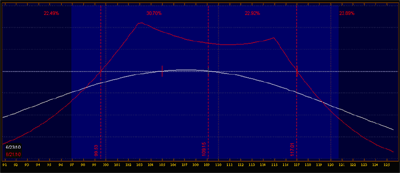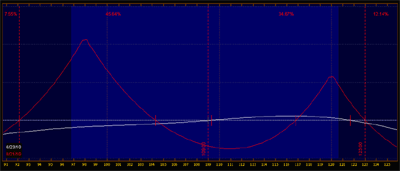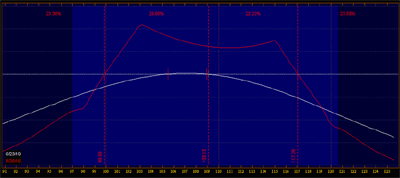When some brokerages calculate margin on complex option spreads, they don’t allow for the fact that it’s impossible for an out-of-the-money (OTM) bull put spread and an out-of-the-money bear call spread on the same underlying both to expire at maximum loss—so they withhold margin on both spreads independently. Options-centric brokers don’t require double margin on a balanced iron condor or butterfly (i.e., where the vertical spreads are equal and all contracts have the same expiration date), but thanks to a regulatory crackdown in the wake of the 2008 credit crisis, it’s increasingly likely that any deviation from a balanced iron condor or butterfly will cost you margin on both sides, at least until the regulations are updated (and the most optimistic estimates for when that might happen are on the order of several months).
So if you want to sell an unbalanced iron butterfly or buy a double diagonal (where the protective strangle has a later expiration than the contracts you’re selling), your return on capital at risk has just been cut in half—or maybe not. In fact, there’s a perfectly legitimate way to construct equivalent positions using a combination of trades on different underlyings. This only works with ETFs or indexes that are highly correlated, and even then, there’s some increase in risk. But by combining trades in, for example, SPY and SPX, it’s possible to create a synthetic position that mimics an SPY double diagonal at a margin cost that still reflects the actual risk, rather than an absurdly strict interpretation of outdated regulations.
Break It Down
An unbalanced position typically can be factored into a combination of two trades. For example, an unbalanced butterfly can be created by adding a vertical spread to a balanced butterfly. Now, this may seem like a convoluted way of trading, but it comes in handy when your broker requires you to put up margin on both sides of an unbalanced position. If the butterfly and the vertical spread are on different underlyings, your margin requirement will be closer to the actual capital at risk because the margin requirement for each component is now determined separately, in a manner that reflects the true risk.
This idea gets really interesting when we apply it to the double-diagonal strategy. The figure below shows the risk profile for the SPY Aug/Sep 98/103/115/120 double diagonal:
In defiance of all logic, federal regulations don’t recognize this as a balanced position, and therefore, want brokers to hold margin on both vertical spreads. But there’s no margin on double calendar spreads, where each time spread has the long and short position at the same strike, and the total cost is just the net debit of the trade. And as previously noted, current regulations do acknowledge that it isn’t necessary to count both sides of a balanced iron condor in the margin requirement.
Article Continues on Page 2
|pagebreak|Put It Back Together
So here’s an example of how we could create a facsimile of the SPY double diagonal above, without putting up double margin. We could have bought the SPY Aug/Sep 98/120 double calendar at a price of about $1.25 per contract, making the total cost for a ten-lot position $1250 (not including commission). The risk profile of that trade is shown below:
Why would anyone want to get into such a sorry-looking mess? Because with the addition of an SPX iron condor, the combined risk profile is very similar to that of the double diagonal shown previously. Here’s how it works:
If we sell one SPX August 980/1030/1150/1200 iron condor (one-tenth the number of contracts in the SPY position), it would be similar to rolling the short SPY August 98 puts up to 103 and rolling the short SPY August 120 calls down to 115—which would give us a synthetic approximation of the SPY Aug/Sep 98/103/115/120 double diagonal. The P/L graph below shows the beta-weighted risk profile of the combined position:
The Bottom Line
At the time we performed the above analysis, the SPY double diagonal was trading for a net credit just over $0.70/share, making the actual capital risk approximately $4300 on a ten-lot position. But if we’re charged margin on both diagonal spreads, our capital cost would come to nearly $9300.
If, on the other hand, we split the position into the SPY double calendar and SPX iron condor, our cost would be close to the real capital risk. The margin requirement for the SPX iron condor, which was mid-priced around $18.80, would be about $3120. Add that to the cost of the double calendar and we get a total cost, including margin, of about $4370.
We’re paying a little extra on commissions, and we have to rethink our approach to adjusting the trade should SPY/SPX reach one of our risk-management thresholds. But in the current environment, where volatility risk has once again become a serious concern, this paired trading strategy at least allows us to keep vega-neutral double diagonals in our toolbox while we eagerly await regulatory reform.
By the Staff at CondorOptions.com























